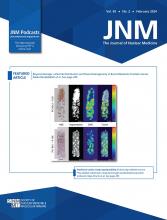Nuclear medicine, with its ever-evolving spectrum of diagnostic and therapeutic interventions, plays a pivotal role in the multidisciplinary approach to cancer care. In recent years, the emergence of targeted radioligands, such as 177Lu-PSMA-617, has offered renewed hope for patients with metastatic castration-resistant prostate cancer (mCRPC) (1–3). These agents have the potential to revolutionize the landscape of mCRPC treatment by offering targeted therapy that hones in on prostate-specific membrane antigen (PSMA)–expressing tumors. However, for these novel therapies to reach their full potential, we must take a meticulous and comparative approach. Herein, we underscore the need for robust comparative studies, acknowledging the reality of the treatment scenario and not comparing only with the easiest to beat and leaving out treatments such as docetaxel or poly(adenosine diphosphate ribose)polymerase (PARP) inhibitors that in the real world would be used in high percentage of patients.
Patients diagnosed with this advanced stage of prostate cancer face a daunting journey, often characterized by progression despite androgen deprivation therapy. Historically, the therapeutic armamentarium for mCRPC was limited. However, the landscape has been transformed with the advent of various treatment modalities, including docetaxel chemotherapy (4), abiraterone acetate (5), enzalutamide (6), 223Ra (7), PARP inhibitors (8), and, more recently, targeted radioligands such as 177Lu-PSMA-617 (1).
The PSMAfore trial, which was presented at the European Society for Medical Oncology congress in 2023, shines a light on the potential of 177Lu-PSMA-617 (9). The trial results are undeniably encouraging, showcasing a substantial reduction in the risk of radiographic progression with 177Lu-PSMA-617 compared with the androgen receptor pathway inhibitor (ARPI) switch. At a median follow-up of 15.9 mo, the trial reported a median radiographic progression-free survival of 12.02 mo for 177Lu-PSMA-617 and 5.59 mo for the ARPI switch, with an impressive 84.2% crossover rate to 177Lu-PSMA-617 for patients progressing on ARPI.
However, the PSMAfore trial carries a notable limitation: it does not include a direct comparison with docetaxel chemotherapy or PARP inhibitors, which remain a standard treatment of mCRPC. Patients included in this trial were not strictly patients unfit for chemotherapy. Therefore, the lack of such a comparator raises essential questions about the optimal treatment sequence and the potential role of 177Lu-PSMA-617 in this context.
Comparative trials are fundamental in the world of oncology. They provide clinicians and researchers with the necessary data to evaluate the efficacy and safety of a new intervention in relation to a well-established standard of care. In the case of mCRPC, such a comparison with docetaxel chemotherapy and others would offer invaluable insights into the role of 177Lu-PSMA-617 in patient management at this particular stage of disease.
A comprehensive comparative study addressing the omission of a direct comparison with docetaxel would undoubtedly have far-reaching implications for patient management in mCRPC.
A comparative study could elucidate the sequence that yields the best clinical outcomes. Is it more advantageous to initiate treatment with 177Lu-PSMA-617, as suggested by the PSMAfore trial, followed by docetaxel? Or does the reverse sequence or another strategy prove superior? Answers to these questions would empower clinicians to individualize therapy for each patient.
As health care systems worldwide grapple with escalating costs, it is imperative to determine the cost-effectiveness of these treatments. A comparative analysis would provide insights into which treatment option offers the best value in terms of outcomes for the resources invested.
The absence of a direct comparison with docetaxel or others in the PSMAfore trial highlights the need for further research. Well-designed, comparative studies should be a top priority in the field of nuclear medicine. These studies could shed light on the potential for 177Lu-PSMA-617 to take its place as a first-line or early-line therapy in mCRPC.
In summary, the landscape of mCRPC treatment is evolving rapidly, and nuclear medicine has a significant role to play. The potential of 177Lu-PSMA-617, as demonstrated in the PSMAfore trial, is truly exciting. However, its full potential can be realized only through comparative studies that offer insights into how it measures up against established treatments such as docetaxel. With a commitment to rigorous, evidence-based research, nuclear medicine can lead the way in redefining patient management in mCRPC. It is only through such research that we can ensure that our patients receive the most effective and personalized care possible.
DISCLOSURE
Kambiz Rahbar reports honoraria from Advanced Accelerator Applications (AAA/Novartis), Bayer Healthcare, and SIRTEX and a consultancy/advisory role with ABX GmbH, ABX-CRO, Bayer, AAA, Pharmtrace, Jahnsen Cielag, Amgen, and AstraZeneca. Martin Boegemann receives honoraria from and has a consultancy/advisory role with Advanced Accelerator Applications (AAA/Novartis), Bayer, Janssen, Sanofi, Merck, MSD, BMS, Roche, Astellas, Exelixis, Pahrmtrace, Amgen, AstraZeneca, Eisai, Gilead, and EUSApharma. No other potential conflict of interest relevant to this article was reported.
Footnotes
Published online Jan. 4, 2024.
- © 2024 by the Society of Nuclear Medicine and Molecular Imaging.
REFERENCES
- Received for publication October 26, 2023.
- Revision received December 4, 2023.







